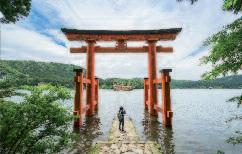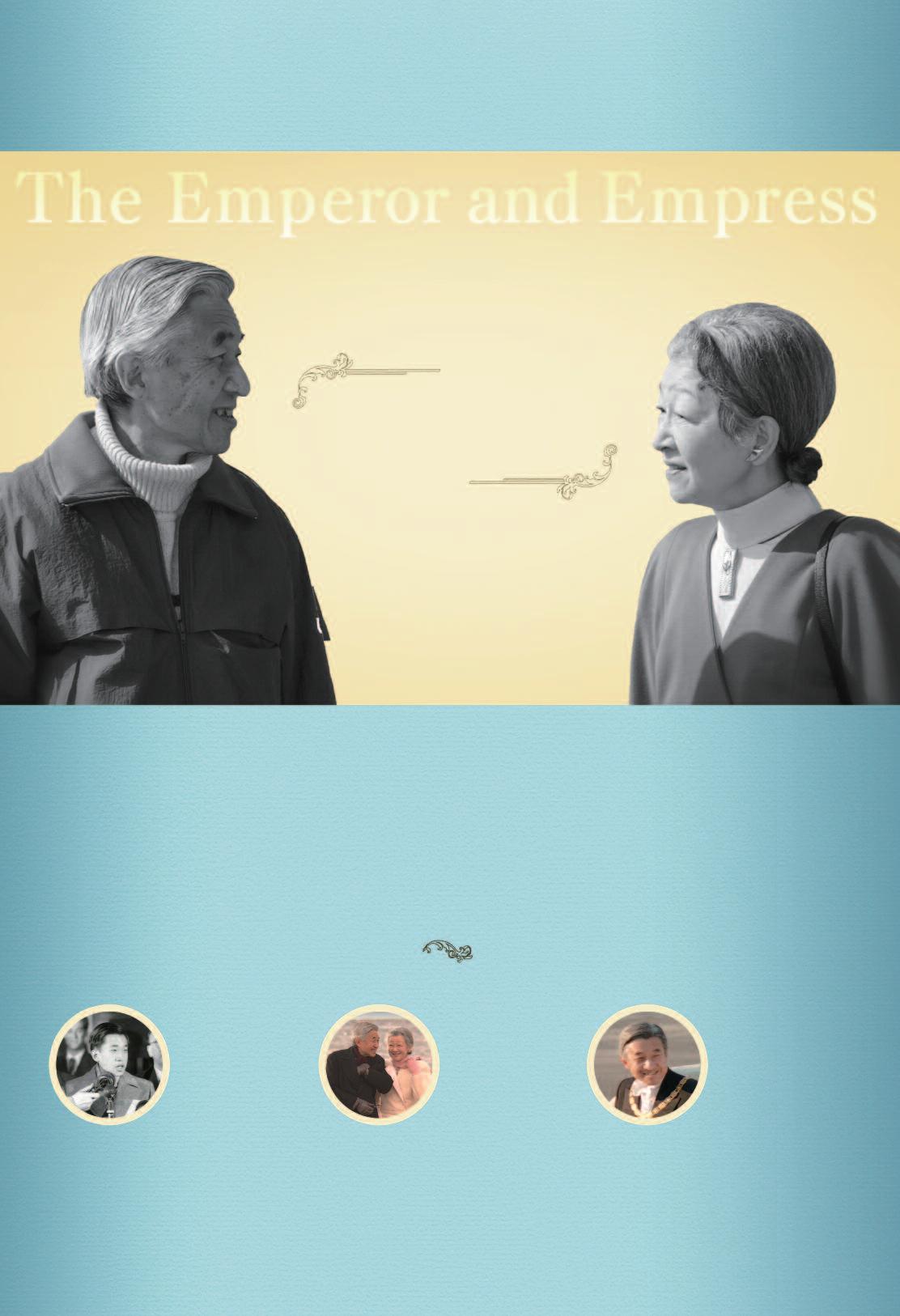





30 years ago, Emperor Akihito took the place of his father Hirohito, who had died in January 1989, and ushered in the Heisei era. Having decided to step down before his death, Emperor Akihito is preparing to hand over the throne to Naruhito, bringing another chapter of Japan’s modern history to a close. So we have decided to devote this issue to an assessment of this significant period during which the country has changed profoundly politically, socially and culturally The environment that has witnessed Japan’s evolution has itself greatly evolved, which partly explains the choices that have been made. But to understand what lies ahead we thought it necessary to take a closer look at the subject
THE EDITORIAL TEAM info@zoomjapan info
That’s the age of TANAKA Kane, the Japanese woman born on 2 January 1903 and who has been named the oldest living person by the Guinness World Records Japan, which has a very high number of centenarians, is quite used to this.
KIMURA Jiroemon, who died in 2013 at 116 years of age, still holds the record for male longevity. In January, NONAKA Masazo, then the oldest man alive in the world, died aged 113.

On 15 March, after a trial lasting one and a half years, a tribunal in Tokyo handed Frenchman Mark Karpelès a suspended prison sentence of two and a half years. The public prosecutor had called for a ten year prison sentence for the former owner of Mt Gox, which by 2014, was the largest bitcoin (virtual money) exchange, for breach of trust and embezzlement.
JAXA, the Japanese space agency, has decided to team up with Toyota. The manufacturer’s task is to build a self-propelled, pressurised moon rover to be launched in 2029. It will be the size of a small bus. The vehicle will be able to carry up to two people for more than 10,000 kilometres, and will be powered by solar energy and hydrogen.




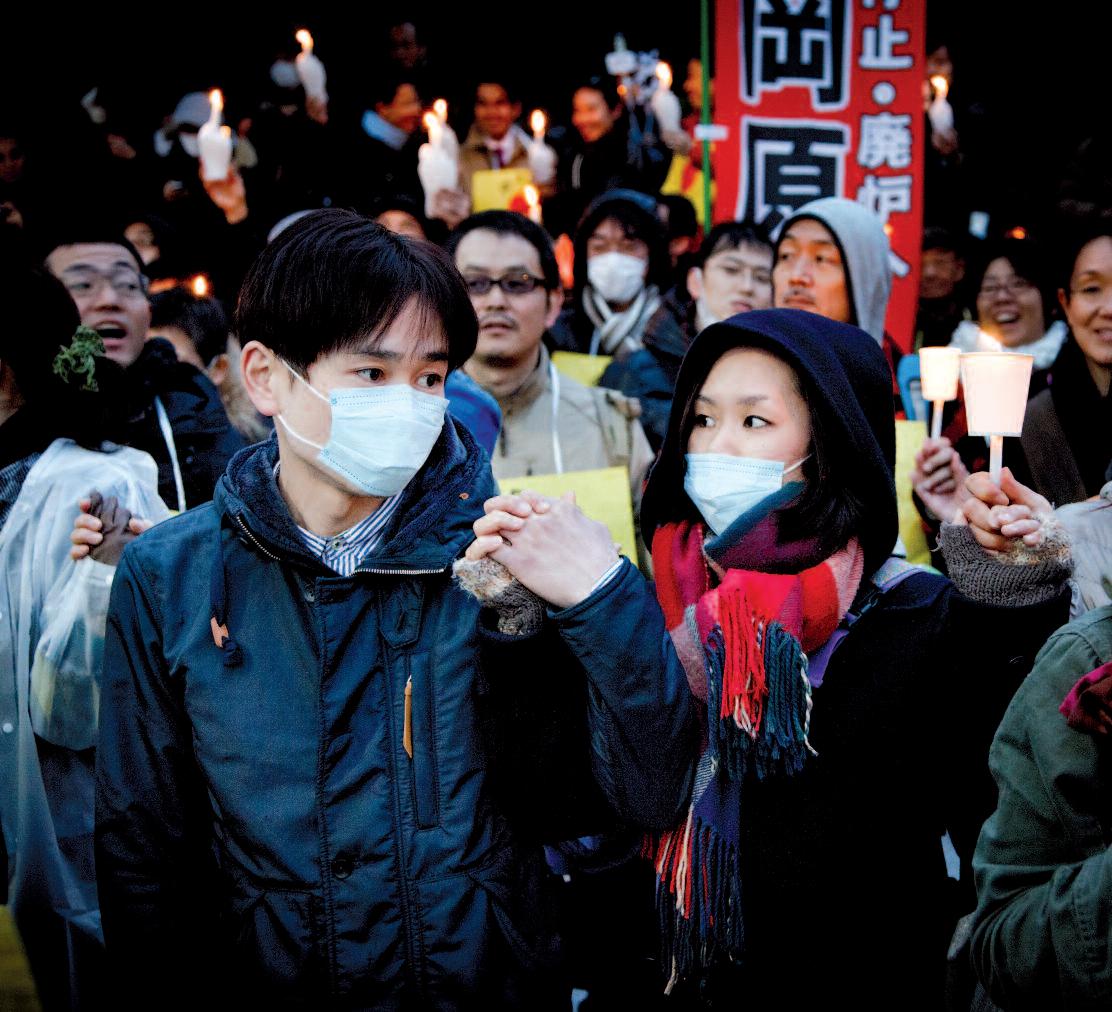
In a few days time, Japan will enter a new era. This presents an opportunity to look back over the last 30 years.
When, in 1989, the Japanese government announced the name of the new era – Heisei, which can mean “achieving peace ” or “ peace everywhere” – one of the country ’ s leading newspapers, the Mainichi Shinbun, conducted a survey of the public's opinion of the new era ’ s name Some 75% of respondents found it “bright” Coming after the
tumultuous Showa period (1925-1989), everybody hoped it was the beginning of a better future. However, 30 years later, when another newspaper, the Asahi Shinbun, asked people how they viewed the soon-to-be-over era, only 5% of respondents said it had been "bright", while 42% believed it was "troubled" and 29% said it was " stagnant " Indeed, much of the Heisei era has been politically unstable, characterised by many short-lived cabinets – with seven prime ministers in the first ten years and 13 in the first 20 only koIzuMI Jun’ichiro (April 2001-September 2006) and
the second ABE cabinet (December 2012 to the present) have been noteworthy for their longevity. In such conditions, many governments found it hard to implement any meaningful polices to address Japan's big problems.
In a sense, the big news was that the conservative Liberal Democratic Party (LDP), which had ruled Japan since 1955, began to crack under the weight of a string of political and financial scandals In 1993 for instance, the party split and a non-LDP coalition formed a cabinet led by former LDP member HoSokAwA Morihiro
More significantly, the Democratic Party of Japan (DPJ) had three consecutive prime ministers between September 2009 and December 2012 on the other hand, it must be noted that all the parties which led non-LDP cabinets (Hosokawa’s Japan New Party, HATA Tsutomu’s Japan Renewal Party and the DPJ itself) were all formed by former LDP members, showing a certain continuity in the way politics was done in Japan
That said, after winning 308 seats in the lower house election in 2009, the DPJ tried to challenge the LDP’s traditional domestic and foreign policy In particular, HAToyAMA introduced new social benefits for families, greatly increased the education budget and expanded welfare He also tried to distance Japan from its close postwar relationship with America by developing a more Asia-focused approach and warmer relations with China, as well as exploring options for limiting the u S military’s use of Japanese bases in emergency situations
kAN Naoto’s cabinet responded to the 2011 triple disaster by reversing the LDP’s pronuclear policy and pushed for a conversion to renewable energy The government eventually shut down all nuclear power plants, leaving Japan without nuclear-generated electricity for the first time since 1970
The Heisei period saw a prolonged fight between the media and the political establishment. Though often accused of being too submissive towards the government, in reality, newspapers and TV broadcasters were active during the first decade in promoting greater transparency, exposing a number of political scandals and changing the way people viewed the authorities They also forced them to reassess the country ’ s past, particularly concerning wartime atrocities and such issues as the Comfort women
In 2009, the ruling DPJ further contributed to this trend of strengthening the media’s role as watchdog when they began to allow journalists from magazines, websites, foreign media and freelancers to attend regular press conferences –a practice which was previously the exclusive privilege of mainstream Japanese media. The move propelled Japan – which until then had been languishing at no 51 in the global index of press freedom – to no. 12.
Even in terms of foreign policy, some of the national dailies and other news media continued their traditionally dove-like emphasis on restraint, mirroring people’s opposition to a more active role for the military (e.g. contributing personnel to uN peacekeeping operations) unfortunately, when the LDP returned to power in late 2012, hawkish prime minister ABE Shinzo began to undo all the reforms of the past few years, constantly attacking anyone – but targeting the Asahi Shinbun in particular among newspapers,

and even the national public broadcaster NHk – every time they dared criticise the government on such issues as nuclear power, contested territory, and the disputed history of world war II.
As a result, Japan fell as low as 72nd place (out of 180) in the 2017 index (in 2018, it gained five places and rose to no 67) as a country where all too often the media as a whole is forced into colluding with politicians, which discourages antiestablishment reporting, while encouraging selfcensorship instead
From 2012, voters have stuck by ABE, hoping that his Abenomics economic policy would end deflation and the country ’ s prolonged recession
In the last six years, the LDP leader has exploited his position of power, strong majority in the National Diet, and a much weakened political opposition in order to reopen a number of nuclear power plants and pursue his conservative agenda one such example is the State Secrecy Law. Promulgated in 2013, this law allows the government to lock away sensitive documents for 60 years. Civil servants leaking information can be punished with up to ten years in prison and a fine of up to 10 million yen while journalists helping them will get five years
The law was criticised by hundreds of academics and several Japanese and international organisations including Human Rights watch, the Federation of Japanese Newspapers unions and the Japan Federation of Bar Associations for being a serious threat to whistleblowers and even journalists reporting on secrets ABE’s other major preoccupation has been the promotion of Japan as a military power.
At the start of the Heisei era, the government had pledged billions of u S dollars for the Gulf war, but constitutional constraints had prevented participation in the war itself. In 2003, prime minister koIzuMI Jun’ichiro approved a plan to send about 1,000 soldiers of the Japan SelfDefence Forces to help in Iraq's reconstruction,
the biggest overseas troop deployment since world war II without a united Nations’ mandate
Finally, in 2014, the ABE cabinet announced a revision of the country ' s defence policy. This was not achieved by revising the Constitution –which has never been amended in its 72-year history – but, instead, by reinterpreting its principle of minimum necessary force, which continues to limit the scope of Japan’s permissible actions toward collective self-defence
This means that Japan can now engage in military action if one of its allies were to be attacked. This move, according to ABE, was necessary to “strengthen mutual cooperation with the united States” According to many analysts, the country is heading in a dangerous direction, as it is seeking new defence capabilities that exceed the limits of its pacifist Constitution
This and similar actions by the government, combined with a growing popular dissatisfaction with political parties and the clumsy way in which the authorities have dealt with natural disasters (such as the 1995 and 2011 earthquakes), corruption and the Fukushima nuclear accident, have encouraged people to play a much more active role in society As a consequence, the last 30 years have been characterised by the creation of many NGos and NPos whose purpose is to provide the kind of grass-roots presence and help that the authorities sometimes fail to provide quickly enough. The post-Fukushima years have also seen more and more Japanese take to the streets to protest questionable government policies such as the State Secrets Law, and the connivance between the LDP and big business.
Meanwhile Emperor Akihito, who is about to abdicate, worked all through the Heisei era to confront the country ’ s dark wartime past, and has expressed his respect for Japan's pacifist Constitution, becoming in the process a new kind of symbol for the Japanese nation
JEAN DEROME
In September 2017, Zoom Japan devoted an issue to the problem of poverty in the A r c h i p e l a g o L a s t y e a r , k o R E - E D A H irokazu’s film Manbiki kazoku (“Shoplifters”) was awarded the Palme d’or and opened the public’s eyes to the phenomenon in Japan 10 years ago, yuASA Makoto published Han hinkon: Suberidai shakai kara no dasshutsu (“Against Poverty in Japan”– not available in English) in which he raised public awareness of the situation in Japan and called on the authorities to take stock of the problem, which had been on the rise throughout the Heisei era (1989-2019). Based on his experience and his commitment to fighting against this impoverishment of society, he takes an uncompromising look back at the past three decades in the hope that the next era will be one of greater solidarity
The showa era (1925-1989) was called the t h e e r a o f t h e m a s s m i d d l e - c l a s s ( Ichioku sochûryû jidai). With the publication, in 2017, of AMAMIYA Karin’s book, whose title could be translated as “The era of mass poverty” (Ichioku sohinkon jidai - not available in English), do you think the Heisei era will be remembered as a period of widespread impoverishment in Japan?
YuAsA Makoto: The Heisei era began in 1989
and just afterwards, we witnessed the collapse of the speculative bubble. It was at that time that we first started to see a number of homeless people on the streets But the phenomenon was not well understood for many years People thought that it was all about“strange” or “odd” people who didn’t wish to find accommodation or work Simultaneously, we saw the appearance of “freeters” [a term formed from the English word “free” and the German word “arbeiter” (worker)], that’s to say young people not in regular employment (hiseikikoyo), but we failed to understand how widespread the situation was. That’s why I think that the Heisei era, which has lasted 30 years, can be divided into two: the first twenty years during which the problem of poverty was completely hidden and the last ten years when people have started to become aware of it
How did you come to consider the question? Y. M.: when I began to become interested in the subject, I didn’t think that it was a question of poverty, but rather a kind of discrimination It was only in 2006 that I used the word “ poverty ” in relation to the problem. It coincided with the end of the koIzuMI Jun’ichiro government, which over 5 years had introduced numerous neoliberal reform policies, in particular making the Japanese social model more flexible. At that time, when I raised the question, people often retorted that this only concerned a few individual cases However many examples I quoted, I was told they were only isolated cases.

In 2009, that changed when the government published the levels of poverty for the first time It was 16% at the time, which meant Japan was the fourth worst country in the oECD, ranked just behind Turkey, Mexico and the united States! Things changed then as society could no longer deny that the phen
official figures They also revealed that poverty particularly affected many women, the elderly and children People also realised that there were different categories of poor people and it was not just about isolated cases as had been claimed. Awareness of the problem didn’t mean that the situation improved Though some l
attempt to correct the situation, they were mostly unsuccessful.
Can you explain why the Japanese have a tendency to deny the reality of the situation? Y. M.: one of the reasons that immediately comes to mind is that it’s very painful to accept there are problems in society There’s always a tendency to want to believe that all is well And when “ we are shown” that things are not going so well, it’s easier to convince ourselves that it’s what people want when you see a homeless person, you wonder how it could have happened, why are they sleeping in the street, should you speak to them? People’s minds are bombarded by a load of questions and it makes them feel uncomfortable So one solution is to say that it’s the homeless person ’ s problem That way, it’s easier to explain things, to clear oneself of any responsibility In my book, I raise the question of “individual responsibility” (jiko sekinin). The term usually means being responsible for one ’ s actions; I think it’s essential to try to take responsibility for one ’ s actions. But in the context of Japan today, it seems to me we use this idea as an excuse not to help others – if the other person is poor, it’s their fault, not mine It’s not my responsibility, it’s theirs, that’s what I call tako sekinin (in reference to the expression jiko sekinin) For me, it expresses a societal or collective irresponsibility, whichever you prefer
The case of “freeters” is interesting. The term, which appeared in the 1980s, refers to young people who refuse to sign conventional work contracts, and reflects the precariousness of the situation now.
Y. M.: you must remember that the term was coined in 1985 by the Recruit company, which

specialised in recruitment, to describe people who refused to be bound hand and foot to a company Many of them found they were not offered regular contracts. In reality, I don’t think they were refusing to have permanent contracts or be regular employees, they just didn’t want to devote their whole lives to their company. That generation of young people refused to follow in the footsteps of their parents who “had done just that and devoted their lives to their company. ” They had watched their fathers work their fingers to the bone and sacrifice themselves no matter what the company demanded Many young people did not want to work in that way. But with the collapse of the economic bubble at the start of the following decade and the resulting crisis, the use of non-regular contracts gained ground and affected an increasing number of men, which was something new. Basically, lots of people just didn’t want to devote their whole life to a company, but their precarious situation was exacerbated and they were viewed negatively by society in general ultimately, it’s connected to the relationship the Japanese have with work over time, work
in Japan has become divided into two halves There are the regular workers whom I consider to be the “ super regular workers” They work full-time, are promoted on the basis of seniority, different life events are taken into consideration (marriage, birth, children’s education, etc ), and they benefit from a high level of social protection. In exchange for this protection, people invest a great deal in their work Conversely, non-regular workers are in a much less advantageous position. Their salaries are much lower and they do not benefit from the same system of social security Even if they are doing the same work, due to their status, they have far less protection. And it’s very difficult for them to live on an hourly wage of ¥1,000 (£6 89) you should be aware that, today, 40% of employees in Japan are non-regular workers, which is a vast number.
This precarity of part of the population has many negatives consequences One of the main ones, it seems to me, is the decrease in the birthrate in so far as births outside marriage are uncommon in Japan. And it costs a lot to get married
Y. M.: Absolutely what’s more, a few days ago, I met some members of the Liberal Democrat Party, which is Prime Minister ABE Shinzo’s party, to discuss the connection between poverty and the fall in the birthrate As a matter of fact, everyone is waiting for a third baby-boom we’ve known for a long time that we have an ageing population, but many demographers are of the opinion that there will be a third babyboom to counteract the decrease But the figures are obstinately static and show that it hasn’t happened and that it will not take place. The main reason for the absence of a demographic r e b o u n d i s c o n n e c t e d t o p r e c a r i t y a n d t h e increase in the number of non-regular workers. we know, for example, that men and women between the ages of 35 and 40 who are still living with their parents and remain unmarried represent around 3 million individuals. These people are non-regular workers and do not have the means to live independently They are not having children And without children, there is no baby-boom. The politicians appear to be looking for an answer to the problem, but I think it’s much too late These people belong to the generation that experienced what is called
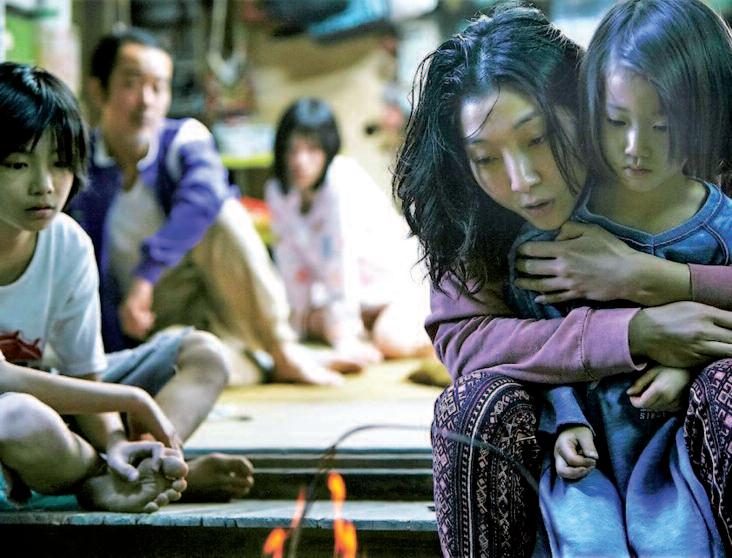
“The Ice Age of employment” in the mid 1990s, and in addition to having to live on much lower wages, they live with a lack of social acceptance In the sense that the model of Japanese society is based on the idea that it’s the man who earns the entire household’s income, it means that to be a “ man ” , you have to be up to the task Consequently, any man unable to achieve this is denied this status. So it’s important to keep in mind that people today around 40 years of age have lived with this stigma for the past two decades and have suffered a great deal I think it would take the same length of time they have suffered for these people to reestablish themselves If they’ve suffered for 20 years, they will need 20 years to recover. They’ll then be around sixty years of age, which is far too late to have children That’s why it is essential for society to be committed to helping them become wholly re-integrated, above and beyond their simple economic role. There’s a need for places where they can meet socially to enable them to at least receive the social recognition they’ve been lacking They must be re-energized so that they can start again, otherwise, the future demographic of the country will be well and truly compromised
Just as the Heisei era will finally be characterised by its recognition of poverty, do you think the next one, personified by emperor Naruhito, will be one of solidarity?
Y. M.: I really hope so. I’ll do everything I can to make it so I’m the manager of an association in charge of canteens for children (kodomo shokudo), which aim to provide meals for un-
derprivileged children. During the past three years, some 3,000 similar places have been set up across the country The people working there are not militants, just ordinary citizens who have realised that solidarity is the only possible response to this problem This movement is a good example of how the upcoming era of solidarity could function
In any case, it illustrates a general rise in awareness of the problem of poverty after years of denial Is it possible to catch catch a glimpse of the kind of solidarity and support that formerly existed at the heart of village life?
Y M : There are similarities, but I see a marked difference. Today’s concept of solidarity is more inclusive than that found in traditional village communities where there was little consideration for the needs of women and children Nowadays, most communities are created with women and children in mind. That said, there are also district associations, closer to the model of these famous village communities, which have helped set up canteens for children. I’m really delighted to see the old model evolve and become adapted to new forms of solidarity
KOrE-EDA Hirokazu’s film “Shoplifters” , winner of the Palme d’Or at Cannes in 2018, gave numerous Europeans the opportunity to learn about poverty in Japan It was released in the final year of the Heisei era; do you think it’s a work that will come to symbolise the era?
Y. M.: This film could indeed be considered as a symbol of the past 30 years Certainly, there’s
been an increased awareness during the last decade, but I think that nothing will change if the public services don’t play a larger part Indeed, the film highlights the lack of support from the State The protagonists do all they can to sort themselves out in their own way. They each have their individual methods of coping This problem has been around for 30 years, and the public authorities are still nowhere to be seen. our greatest challenge is to reintroduce public services and take practical action to improve the situation of these deprived people
Now that Japan is getting ready for a new Imperial era, the government hopes to change the immigration rules Don’t you think that these foreign migrants might be caught in the poverty trap if there were an economic downturn?
Y M : It’s definitely something to worry about The government continues to say that it’s not about an immigration policy. They put forward the idea that people come to Japan, work here for 5 years then return to their own country In reality, no one really knows how things will pan out. The possibility remains open for family members to come too, but we still have no idea how this might work out By not admitting it’s about an immigration policy, the government is taking no steps to encourage the integration of these migrants For instance, there are no plans to teach them Japanese, which won ’ t help them integrate, rather it will encourage their exclusion, even push them into poverty in the event of difficulties Luckily, in some places there are cultural exchange centres to help make good some of these discrepancies
These problems have been around and have been on the increase over the last decade or so But there’s still a tendency to deny the reality of Japanese people living in poverty. For example, there are schools around Nagoya, where there’s a large community of Latin American migrants Many of them are the descendants of people who emigrated to this part of the world at the start of the 20th century. 50% of the children there do not have Japanese nationality There is no requirement for them to lean Japanese They find themselves in an education system which copies one to teach disabled children. Many of them have no access to mainstream schooling and are trapped up a blind alley in Japanese society. This has been the situation for a good twelve years, but the government shows no interest in doing anything about it I don’t see how things can get better if they remain vague about how they intend to deal with immigration The risk of increased poverty and exclusion can only get worse
INTERVIEW BY GABRIEL
BERNARD
As a leader in technology, Japan has seen its position increasingly challenged during the past three decades.
For many years, Japan was famous for its ability to learn from foreign cultures, importing their technology and improving on it At the same time, because of its history of political isolationism, it is said to have developed an island mentality that has resulted in both original inventions and headscratching practices and attitudes towards technological innovation The following is a brief h
Heisei period
In the past 30 years, Japanese companies have played a leading role in the automotive market, producing very affordable, reliable and innovative cars In the process, Japan became the largest car-producing nation in the world in 2000, while, in 2008, Toyota overtook General Motors as the world's largest car manufacturer However, in the last few years, new competition from China has reduced the country ’ s market share. In 1997, Toyota started selling the Prius, the first mass-produced hybrid car in the world, which rapidly assumed cult status thanks to endorsements from environmentally-minded celebrities such as Leonardo DiCaprio and Cameron Diaz
Today, the Prius is sold in over 90 countries, with Japan and the united States being its largest markets, while its hybrid system is installed in around ten million of its cars and licensed to other manufacturers, including Nissan and Ford. At the same time, strong competition from Tesla and other car makers prompted Toyota to push forward towards yet another technological revolution: hydrogen-fuelled cars. The idea had been developed first by Mazda who, at the 1991 Tokyo Motor Show, unveiled the HR-X prototype However, Toyota quickly replaced Mazda as the main developer of hydrogen fuel technology, creating the innovative Mirai Hydrogen is considered the final word in clean fuel because the chemical reaction in a fuel cell produces only water. It’s also quick to refuel, unlike batteries. on the downside, hydrogen is expensive and difficult to store, and cars like the Mirai require the creation of a huge and expensive infrastructure for hydrogen production, transportation and bulk storage There are still many problems to solve: in February 2017, for in-

stance, Toyota recalled all the 2,800 models it h
system The cars were quickly fixed at no cost to the customers
Mobile communication
Mobile communication in Japan took off in the early 1990s thanks not to mobile phones but to pagers, or Pokeberu (pocket bells) as they were called in Japan. First launched in 1987 and marketed as a useful business tool, their small size and low price made them increasingly popular among the general public By 1991, there were about 5.75 million pager subscribers in Japan, and the next 4-5 years saw a boom in sales especially among the young, p
. Pokeberu usage led to original ways to communicate –using numbers instead of letters to spell words (each digit can be pronounced according to the Japanese syllabic alphabet) – and became the first rudimentary form of social media, way before the advent of Myspace and Facebook The second phase in the development of mobile communication was the advent of small-sized mobile phones, which became popular thanks to the implementation in 1995 of the Personal H a n d y - p h o n e S y
( P H S ) , a t e c h n o l o g y that had been developed by NTT in 1989. while PHS phones had a limited range, they worked well in Japan’s dense urban areas and were very cheap
H o w e v e r , P H S w e r e s o o n r e p l a c e d b y t h e more advanced keitai (mobile phones) which ushered in keitai culture In 1997, J-Phone unveiled the Pioneer DP-211Sw, which not
only featured a liquid crystal touch screen but could display kanji (a rare thing at the time) and emoji, which were first created by interface designer kuRITA Shigetaka In the same year, NTT Docomo started working on internet connectivity (coincidentally, the world wide web was invented in 1989, when the Heisei period started) and in 1999, was finally able to launch the revolutionary i-mode service, with the “i” standing for internet, information and interactivity. For the first time, keitai users could connect to the internet and send emails and some 200 emoji By the end of 2000, about

In 1999, NT Docomo launched the revolutionary i-mode service
half the Japanese population was using keitai Mobile phones contributed in many ways to changing people’s habits. For instance, people could now read “cell phone novels,” literary works written on keitai via text messaging whose chapters usually don’t exceed 70-100 words. The first mobile phone novel, Deep Love, came out in Japan in 2003 and became so popular that it was also published in book form, selling 2 6 million copies

Some other cultural changes brought about by keitai culture have not been so positive. Cinemas, for example, now regularly show ads telling people to turn off their phones before the show starts
At this point, Japan was still the leading country in mobile communication, and strengthened its position with the creation of the camera phone whose first model, the Sharp J-SH04, came out in 2000. with a 0.11-megapixel camera and the ability to send photos via the so-called “sha-mêru” (photo mail) service, it became wildly popular both in Japan and the west while Japan’s world supremacy was ended for good when Apple launched the iPhone in 2007, local companies have continued to create new communication devices, the most popular being Line, a smartphone and PC app that allows users to make calls and messages with other Line users, both nationally and internationally. Launched in June 2011 as a response to the 2011 Great East Japan Earthquake, which devastated communication infrastructure, it attracted 45 million users in the first 13 months, becoming in 2013 Japan’s largest social network and most popular messaging app Currently, it boasts 700 million users in 230 countries around the world, though it is most popular in Japan and other East Asia countries.
Today, people use it to call taxis, play games and buy things using cryptocurrency Line has also reworked the emoji concept into threedimensional e-stickers called “ stamps ” .
Japan has been the pioneer of developments of a number of digital products For example, in 1986, just before the advent of the Heisei period, Nikon began selling the first digital
single-lens reflex (DSLR) camera, the Nikon SVC, introducing the epoch-changing digital camera In the mid-to-late 1990s, DSLR cameras became popular with consumers, largely replacing film cameras at the turn of the century In the highly competitive digital television market, the Japanese MuSE standard was, until 1990, the front-runner among the more than 20 different technical concepts developed worldwide. The first public digital high-definition (HDTV) broadcast was of the 1990 FIFA world Cup in June that year However, the MuSE standard was successfully challenged by foreign competitors, and even in Japan it was later replaced by the ISDB standard (2003), which is also being adopted by South America and the Philippines
Though DVD technology is the result of a collective research effort in Japan, Europe and the uS, such companies as Sony, Panasonic and Toshiba have contributed to its development, releasing the standard DVD (and the first DVD player) in the mid-1990s
In 1994 NEC, together with other foreign companies, began the development of the uSB, which has become a common tool for connecting different types of devices such as keyboards, printers, cameras, scanners, etc.
Isamu and AMANo Hiroshi invented the first
(LEDs) now commonly used in bulbs. For their energy-saving invention, the three were awarded the 2014 Nobel Prize in Physics
Electronics industry
During the Heisei period, the once dominant Japanese electronics industry lost its world su-
premacy to South korean, Chinese and Tai-
some of the categories where Japan lost significant market share The 2008 economic crisis further contributed to their financial woes, with Sony, Hitachi, Panasonic, Fujitsu, Sharp, NEC and Toshiba reporting losses amounting to $17 billion (£12 8 billion) By 2009, korean g
than twice the combined profits of nine of Japan’s largest consumer electronics companies
Galapagos syndrome
while emoji became wildly popular worldwide and incorporated in ioS and Android phones, making them part of the way people communicate around the world, other Japanese inventions haven’t travelled so well abroad, giving r
commonly known as the Galapagos syndrome A prime example are mobile phones. Japanese companies tried to launch the then-advanced i-mode system in other countries, but mobile phones were quickly replaced overseas by the smartphone. Even today, the local market is still divided into a high-end sector (smartphones) and a mid-to-low-level sector (garakei or Galapagos keitai)
around In fact, their service will only come to an end this September

Seen from abroad, the survival in Japan of this outdated technology may seem strange, but after all, this is a place where you can still send telegrams, and more than a few companies continue to prefer fax machines to email
It’s taken 30 years for the otaku subculture to become established, both in Japan and the rest of the world.
The Heisei period witnessed the advent of an otaku Golden Age that has taken not only Japan but the whole world by storm Nowadays, the words manga and anime can be found in most dictionaries, otaku culture is celebrated at countless conventions around the world, and Japanese comics and animation are widely available in many languages – not only the giant robot sagas that first became popular in the west but even shojo manga (aimed at teenage girls) and “boys’ love” stories
However, the Heisei period started in the worst possible way for the otaku community: the new era was only six months old when, on 23 July 1989, MIyAzAkI Tsutomu was arrested for sexually attacking a schoolgirl, and later confessed to murdering four children aged between 4 and 7, and sexually molesting their corpses. The police found 5,763 videotapes in his house including many anime, slasher and horror films, prompting the media to call him the otaku Murderer
Public opinion of manga, anime and video game fans hadn’t been positive to begin with –the word otaku itself had been used first in 1983 by essayist NAkAMoRI Akio to describe all “socially inept young males” who, according to him, were guilty of seeking refuge in a fantasy world made up of toys and cute girls However, MIyAzAkI’s murders made things much worse, creating the idea that young people involved with anime were dangerous, psychologically disturbed perverts
Back in the late 1980s and for most of the 1990s, being an otaku wasn ’ t something one could openly share with other people Otaku typically occupied the lower ranks of the school hierarchy; they were bullied by other boys and regarded with disdain by girls. As a consequence, for many years it remained an underground subculture whose members met at little advertised events and were kept informed through Animage, Newtype and other magazines that appeared at that time
At the same time, a number of titles began to creep into mainstream popular culture, starting w i t h t h e D r a g o n Q u e s t r o l e - p l a y i n g g a m e created by HoRII yûji with the specific goal of appealing to a wider audience The game ’ s artwork was drawn by manga artist ToRIyAMA Akira whose anime series Dragon Ball Z premiered on Japanese TV in 1989 and became a huge national success Then, three years later,
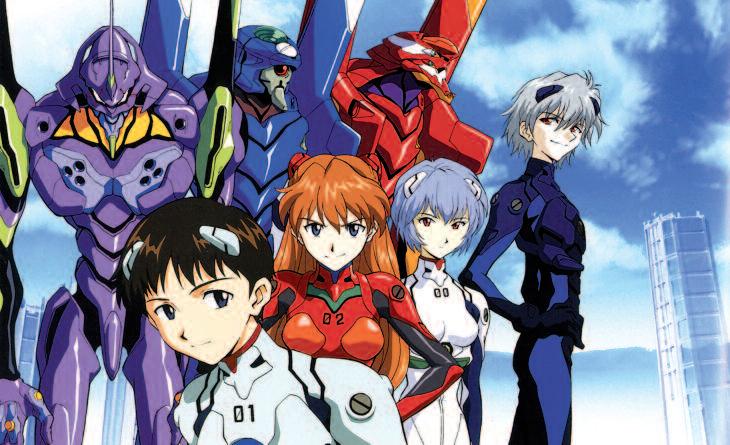
TAkEuCHI Naoko’s Sailor Moon became an equally successful anime series, which ran until 2007, heralding the bishojo magical girl genre that until then had been considered the exclusive domain of the nerdy crowd
Both Dragon Ball and Sailor Moon would later spearhead otaku culture’s invasion of Europe and America However, on the home front nothing eclipsed the impact of ANNo Hideaki’s Neon Genesis Evangelion, an anime series which reworked the classic mecha (giant robot) genre in new and unexpected directions, giving more emotional depth to its characters while introducing philosophical, psychological and even religious themes Though Evangelion’ s original 26-part series only ran on TV in 1995-96, it quickly became a cultural phenomenon and contributed to giving more social exposure to
the otaku community
A key factor in Evangelion’ s popularity was the commercial success of its ever-expanding line of related merchandise Indeed, it was around this period that shop owners, publishers and other companies began to realise otaku culture’s business potential Manga and anime fans were still seen as weird and a little scary, but they were certainly good consumers with great spending power, which seemed unaffected by the end of the bubble economy with the number of Japanese children shrinking at an alarming rate (the country ’ s fertility rate had sunk to 1.57 births per woman by 1989 and would continue to fall until it hit a record low of 01 26 in 2005), the entertainment business started targeting the otaku population and their bottomless pockets.


Eventually, otaku fans found their promised land in Akihabara, a Tokyo district that had been a shopping centre for radio components after the war before switching to electrical appliances, but that in the 1990s began to sell home computers This process culminated in 1994 when computer-related sales surpassed other consumer electronics for the first time Many computer hobbyists were also into manga, anime and video games As a consequence, the new PC DIy era saw a gradual transformation of the area: with the release of a new generation of game consoles (Sega Saturn, PlayStation and Nintendo 64), more and more retailers started to sell game software, including manga and anime-based products In the second half of the 1990s, otaku culture became more mainstream with the growing popularity of idol groups and maid cafes – both highlighting and exploiting fans’ moe factor or their love for cute young girls Formed in 1997 by singer-songwriter Tsunku, the idol group Morning Musume developed a model (later re-
fined by the AkB48 franchise), in which the distance separating the idols and their fans was dramatically reduced. These groups, for instance, regularly appear at Handshake Conventions all over Japan where their fans can meet and chat with them and even have their picture taken with their favourite band member. Some groups went so far as to experiment with hugging and even “whisper events ” (i e whispering sweet nothings in their fans’ ears) Idol group producers such as AkB48’s AkIMoTo yasushi also came up with the great idea of creating “unfinished” idols whose immaturity and amateurishness attracted male fans Maid characters first appeared in anime in the 1980s, but definitely captured the otaku imagination in the 1990s with PC dating simulator game Welcome to Pia Carrot!! In 1998, a temporary café was opened to promote the game ’ s sequel, while the first permanent maid café (Cure Maid Café) appeared in 2001 This novel idea became so successful that, according to business news website SankeiBiz, in the following

decade 282 similar establishments opened in Akihabara alone. Many of them didn’t survive the intense competition, but maid cafés are still one of Akiba’s more recognisable features In the process, they have somewhat broken out of the moe stereotype, and now many places are frequented by women, students, couples and tourists with anime, idols and maids appearing on primetime TV, and game consoles like Playstat i o
homes, the social stigma attached to otaku appeared to slowly dissipate However, the single event that contributed most to the change in people’s attitude was the Densha Otoko (Train Man, 2004) phenomenon This allegedly true story of a 20-something geek who falls in love with a girl originated on the 2channel message board, and spread from there like wildfire, eventually becoming a novel, a manga, a film and a TV series, all of them extremely successful, demonstrating in the process that these otaku were not so dangerous after all, and that some were actually quite cute
In the new century, otaku culture has become almost unstoppable in its pursuit of ever new markets During the “Akiba boom” of the mid2000s, the district was regularly featured in the media as a centre of a thriving subculture, and was soon followed by similar areas in other major Japanese cities like Nipponbashi (also called Den-Den Town) in osaka, and osu in Nagoya The latter city has also become the world capital of cosplay thanks to its world Cosplay Summit, which attracts fans and contestants from around the world every year As for idols, 2009 was the year when Akimoto organised the first AkB “election” where fans purchasing AkB CDs were given tickets to vote for their favourite girls The results were then broadcast on television from massive arenas. Among other things, manga, anime and idols have become a powerful tool in raising Japan’s image abroad The idol groups, for instance, have developed fan bases across Asia, with the AkB project giving birth to sister groups such a s J k T 4 8 i n J a k a r t a , S N H 4 8 i n S h a n g h a i , BNk48 in Bangkok and MNL48 in Manila
Nowadays, on a trip to Tokyo or other major Japanese cities it’s apparent how much otaku “sights and sounds” are part of Japanese life, from giant billboards and graffiti to the jingles in some train stations. Manga, anime and other pop culture icons are now so embedded in the Japanese psyche that comic characters are everywhere, from TV commercials and food packages to corporate logos, police mascots, and posters devoted to public safety It really seems that otaku culture is here to stay
GIANNI SIMONE
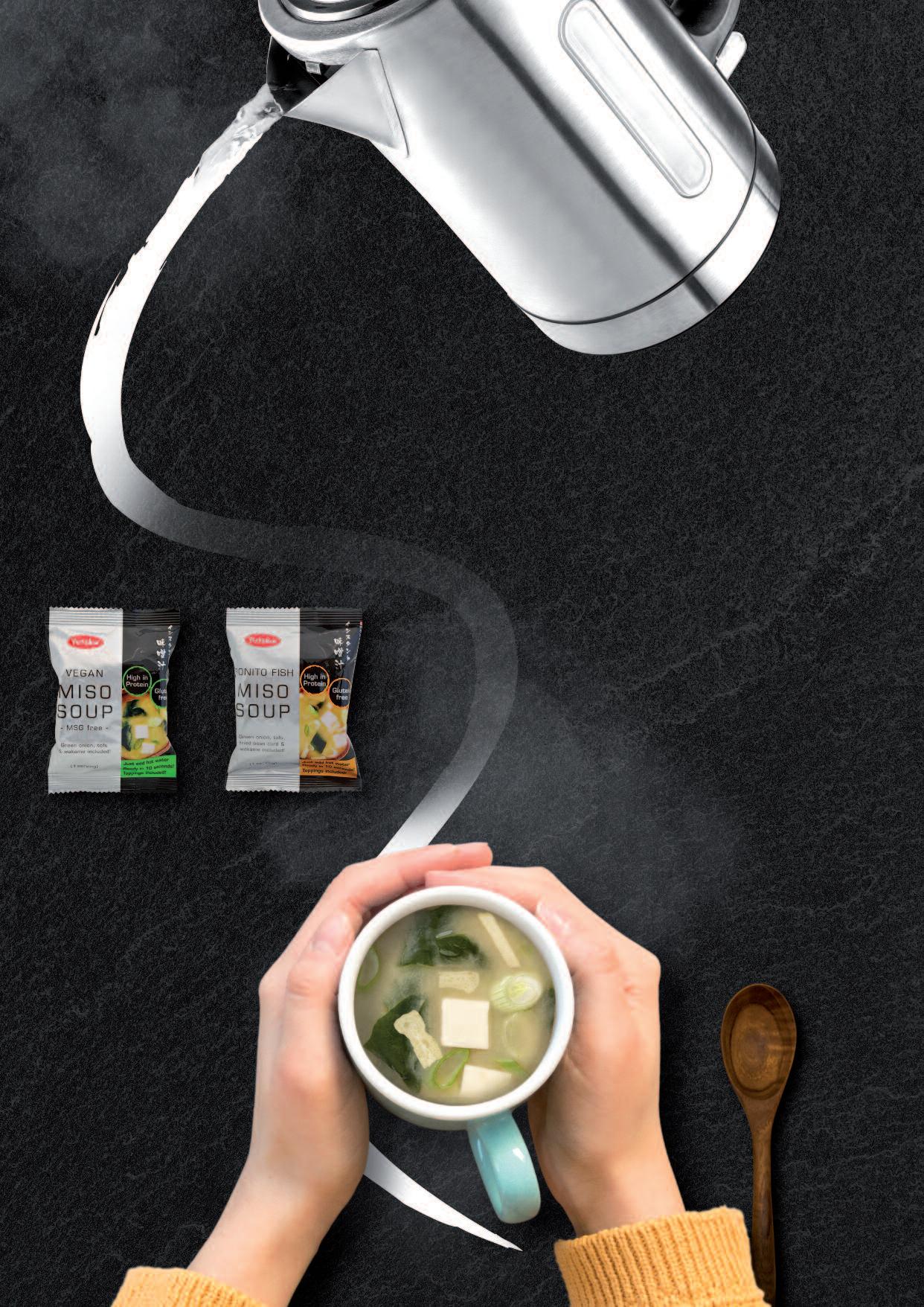
This city of 88,000 inhabitants has decided to gamble on the future and teach children the art of eating well.
When the lunch bell rings in konan elementary school in Fukuroi, in Shizuoka Prefecture, everyone knows what to do As in many other Japanese schools, the tables are rearranged and meals are eaten in the classroom. It’s the pupils themselves who take turns to serve their classmates Supervised by adults, those whose turn it is don a white coat and a hairnet, wash their hands and go down to the ground floor to collect the trolleys containing the hot meals, delivered a few minutes earlier in a van from the central canteen on today’s menu there’s samara, a local fish served in a sauce, vegetable soup with pasta, and two slices of bread with chocolate spread To drink, there is a carton of milk
The children are familiar with the process They collect the containers of hot food on trolleys, stack the trays, put out the cutlery and chopsticks Their fellow pupils queue up and wait patiently until everything is ready when it’s all been set up like a cafeteria, the children each take a tray and are served by those in charge for the day The latter conscientiously serve out the carefully prepared meals onto the plates once the children have been served their meals, they have exactly twenty-five minutes to eat, not a minute more “we hope the children will concentrate on what they are eating, ” explains koBAyASAHI Mihoko, the nutrition teacher attached to the school since 2005 “once they’ve finished, they can talk to each other and go to play in the courtyard Not before ” As soon as the food is on their plate, they must sit down and eat or risk having the unfinished meal removed at the end of the allotted time koBAyASAHI Mihoko intervenes during the meal “ so that the children will think about what they’re eating.”
“I talk to them for a few minutes during the meal about the food they’re eating I tell them where the ingredients come from and the food groups they belong to. My role is to teach them about a healthy and varied diet, to encourage them to improve their eating habits and persuade them to give proirity to vegetables and seasonal products I also make them aware of waste by telling them all about the work of the local farmers, for example Throwing away food is all about a lack of respect for those who’ve worked hard to provide it, and the children are very open to this argument It encourages them not only to finish their meals but also to try
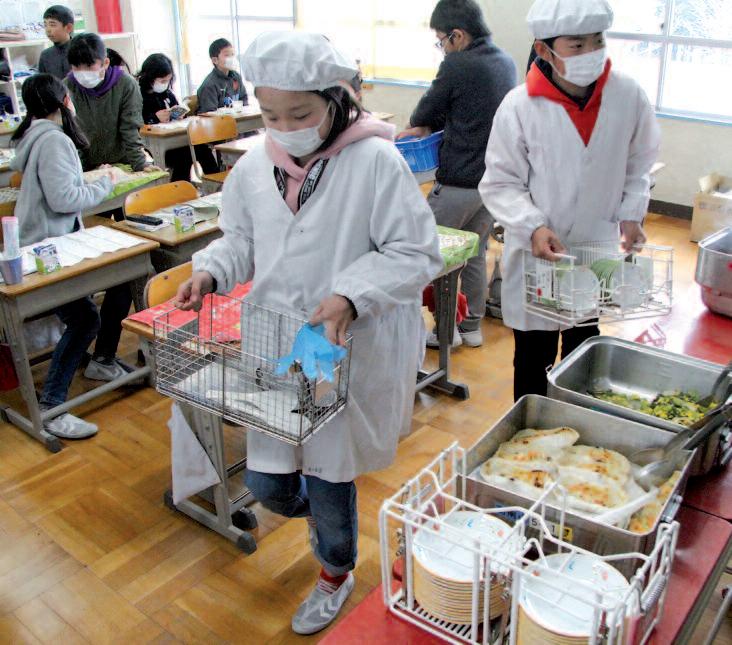
something they wouldn’t want to eat in the first instance,” she adds. when the meal is finished, the plates are almost all empty Ryusuke, aged 11, doesn’t like the fish served today, but eats it nevertheless, with encouragement from the nutritionist and his classmates “It’s important to try it,” he says between mouthfuls, without great enthusiasm The rest of the class appear to have been won over and are delighted they can finish their meal with a chocolate spread sandwich once the room is cleared and the rubbish sorted, the children go the bathroom to brush their teeth, and the ceremony comes to an end. In Fukuroi, the amount of waste food collected shows that 95% of the town ’ s pupils finish their whole meal. It’s an achievement envied by other cities in Japan, an increasing number of which are coming to visit to learn more about this innovative programme “young children adopt the eating habits they’ll have in adulthood. So it’s now, at school, that there’s everything to play for and they should be taught good habits and practices for the future ”
ISHIzukA koji keeps a close eye on the programme He is one of the people in charge of the central canteen and oversees the city’s school meals service He was the one who instigated
this successful nutritional programme, which was awarded a prize last year for good practice in the educational sphere at the 8th Global Conference of the Alliance for Healthy Cities in Malaysia His idea was simple but extremely effective: by dramatically improving the links between the 26 producers of food in the city and the central school meal canteen, he ensured that Fukuroi was able to create and deliver a variety of balanced meals to a large majority of the city’s school children while, at the same time, boosting the local agricultural economy “A nation-wide study highlighted the fact that in the country as a whole, the diet of Japanese children was very deficient in calcium and that some groups of food rarely appeared on the menu, ” he tells us. “we thought about how to overcome these problems so as to optimise the nutritional benefits of each meal while making sure they remained tempting for the children ” The kitchens of the central canteen in Fukuroi, which were launched in 2013 and employ 80 people, provide food for fourteen nursery schools, eighteen elementary and four primary schools, have only one rule to follow: no skimping on either taste or quality And to achieve this, when beef burgers are served to Fukuroi’s schoolchildren, they are made entirely by hand, as are the harumaki
(fried spring rolls) yet another example is that, before being cooked, all the vegetables are hand washed, and leafy vegetables such as cabbages are spray rinsed in order to “ remove all the dust and stubborn insects ” This procedure - with its many precise details - is unique, even in Japan. The menus are never decided in advance; it’s the teaching staff, with the support of the nutritionist, who devise the menu each month depending on both what is available and nutritional requirements, but also what the children like to eat “we know they’re very fond of fried chicken, meat, and vegetable croquettes we try to include their favourite foods with other dishes to create balanced meals,” he explains Finally, dishes are also adapted for children with allergies so that they “ can eat the same meals as the others,” but prepared without the ingredients they cannot eat The local government finances the entire running costs of the canteen and the employees’ salaries, and parents pay ¥250 (£1 70) towards the cost of every meal. In addition to balanced meals, the children receive lessons about nutrition and what they need to eat, always in the hope that these good eating habits will be replicated in their homes. one of the important goals for ISHIzukA koji was to succeed in increasing the quantity of vegetables consumed by the children so that they would continue to eat them in the future. “It’s a good way, it seems to me, to lower medical spending in the future Good eating habits are the best guarantee of good health in adulthood,” he assures us This is the reason why, in five years, “the amount of vegetables eaten by children has risen from 89 grams to 104 grams per meal By giving priority to local seasonal produce in our kitchens, we ’ ve also been able to boost the volume of local agricultural production, by increasing the amount we use from 8% to 31% ”
It’s 10 o ’clock in the morning, on 62-year-old SuzukI Toshiyuki’s small farm. 10 years ago, he gave up his salaried job in business to become a farmer and produce vegetables such as bok choy (Chinese cabbage), as well as spinach or its Japanese equivalent, komatsuna. Bok choy is one of the mainstays not only of local production in the city of Fukuroi, but also for the kitchens of the central canteen, which is one of this local farmer’s most important clients. He alone represents “ an annual volume of 10 to 12 tonnes, ” he says delightedly “It’s quite an easy vegetable to cultivate, even in winter, as it doesn’t need a lot of care and grows well in greenhouses ” It can be harvested about forty days after germinating He uses only organic fertilizer in the soil to grow his vegetables – no chemicals. And to water his plants, SuzukI Toshiyuki has opted for a system that reproduces the effect of light rainfall for one hour every day in his plastic
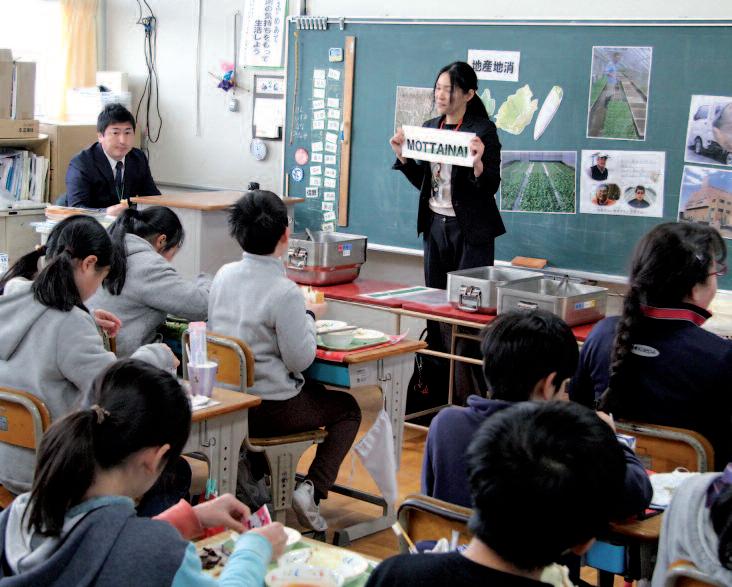
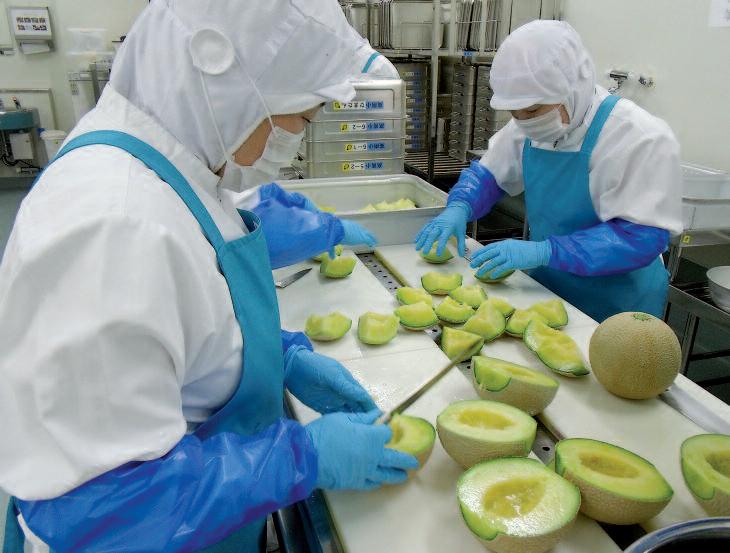
covered greenhouse
Not far from his young cabbages, the farmer has set up a small table on which he has spread d r a w i n g s a n d w o r d s o f e n c o u r a g e
thanks from the pupils from konan School “They regularly come to visit the farm,” he smiles. “we sometimes organise workshops on the farm, where I and my wife explain how we produce vegetables And sometimes, the children invite us to come to share their lunch at school,
they’re really sweet I have four children, and my grandchildren are at the nursery school or in Grade 1. So it’s very moving to see these little ones showing an interest in my vegetables,” he confides He thought of giving up farming at 60 years of age, but encouraged by the children, and “ as I’m in good health, under these circumstances, I can see myself cultivating my vegetables for the next ten years at least ”
JOHANN FLEURI
In the vicinity of the former Tsukiji fish market, there’s a shop selling the highest quality kitchen utensils.
She is THE young woman of Tsujiki, the
yuki, whose grandfather founded this kitchen
u
light-filled little shop. Since the relocation of the famous fish market to Toyosu, the character of the place has changed; it’s no longer the reserve of professional working people, but filled with tourists, mostly foreigners, a mix of Asians and Europeans, who continue to frequent the popular, bustling district, which is much closer to the capital’s centre than the new large market This family business used only to supply only professional clients, but yuki hoped to open up this new shop to amateur cooks, so that her generation, who had lost many of the traditional c o o k i n g s k i l l s , c
Japanese kitchen utensils
A tawashi scrubbing brush, made from natural palm fibres, hangs outside the front of the shop It’s very useful for cleaning dirt off vegetables without having to peel them on the counter there’s a bowl to grind sesame seeds with instructions in Japanese and English “I would like peop l e t o d i s c o v e r t h e f l a v o u r o f
sesame Nowadays, sesame seeds are sold in plastic sachets, but they have no taste The raison d’être of traditional kitchen utensils is to enhance the
TSUKIJI HITACHIYA, 4 chome 12-5, Tsukiji, Chuo-ku, Tokyo, 104-0045
There’s another outlet in Amakusa, in the Marugoto Nippon building. www.hitachiya.com


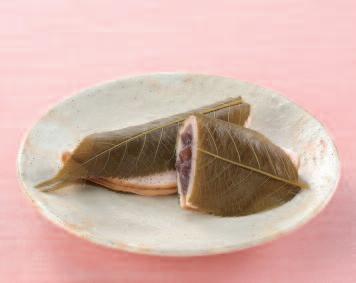


longer than using so called ‘modern’ utensils,” the young woman assures us
wood, bamboo or copper need more care than
they can be repaired or sharpened by skilled people, to guarantee they’ll last for many years.
many other people But while on a work placement with a rice producer, her eyes were opened to the authentic taste of natural products and home-made food
“Today, many foreigners are interested in Japan’s
cuisine I want to introduce these enthusiasts to the key to cooking our Japanese delicacies w i t h t r a d i t i o n a l u
it’s easier to recreate the taste of authentic Japanese food And, above all, it’s pleasurable to cook using utensils made by Japanese craftspeople, isn’t it?” she adds
A few steps away from her shop, she has opened a cellar selling wine and natural sake where you can also find sun-dried vegetables (she’s published a book on the subject) and fermented foods… It's an ideal place for a break to taste some hot sake or natural wine
SEKIGUCHI RYOKO





For the rice with bamboo shoots:
(Rice with bamboo shoots and rape florets with sesame seeds)
1 - Rinse the rice three times Drain then set aside to swell for 30 minutes
2 - Chop the carrot and the fried tofu into 2 cm long lengths Finely chop the bamboo shoots

3 - Place the rice, dashi, water and other ingredients in the bowl of the rice cooker, and cook
4 - Once cooking is complete, allow to rest for 10 to 15 minutes then stir
Tips: In Japan, bamboo and rape announce the arrival of spring Tinned bamboo shoots are available in the UK If you have difficulty finding rape florets, you can use sprouting-broccoli, which has a similar taste, or spinach.
For the rice with bamboo shoots:
450 g short grain rice
200 g bamboo shoots
½ carrot
1 slice of fried tofu
5 tablespoons concentrated dashi
500 ml water
For the rape florets with sesame seeds:
150 g rape florets
60 g tinned tuna in oil
1 tablespoon sesame oil
¼ teaspoon salt
2 tablespoons white toasted sesame seeds
For the rape with sesame seeds:
1 - Rinse the rape florets then blanch in boiling water for 5 to 7 minutes
2 - Drain
3 - Cut the florets into 2 cm lengths
4 - Put the rape, tuna, oil, salt and sesame seeds in a bowl.
5 - Mix together well and serve






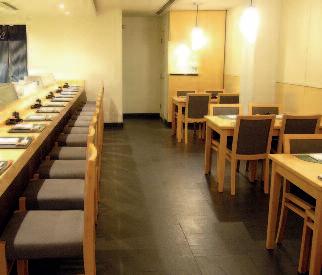


The celebrated spa is well-known as a place that has succeeded in preserving the atmosphere of the Edo era.
With its hundred-year-old traditional inns, hot-water springs, lush landscape and views over Mount Fuji, the Hakone spa, situated an hour and a half to the west of Tokyo, is a favourite destination for travellers and Tokyo inhabitants badly in need
o
that it was of historic importance during the Edo period (1603-1868), and, to this day, there is a great deal of evidence of this to be seen in its many
perfectly preserved locations. undoubtedly, the most obvious example is Hakone Hachiri, registered as a National Heritage site in 2018 Hakone Hachiri was a key stage on the Tokaido road, a major trading route before the Meiji Restoration, which is 492 kilometres in length and which, at that time, linked kyoto to Edo, Tokyo’s former name Fifty-three stopping-places are dotted along the road, many of which have become famous and have often been cited in poems or depicted
Three Stations of Tokaido series of wood-cut prints by uTAGAwA Hiroshige Contemporary eye-witness accounts of the road have been care-
fully preserved to the present day. The Hakone section, which connects the towns of odawara and Mishima, was considered the most difficult to travel along “For a long time, these towns were control-points,” explains SuwAMA Jun, director o
check-point was abolished, people began to move to live and profit from the flourishing economy in the region. Transport networks were developed and multiplied, which encouraged trade ” The name Hakone Hachiri is made up of two parts: hachi (eight) and ri (a unit of length) This stage extends exactly 32 kilometres from odawaraj
shuku on the Hakone side, at an altitude of 846





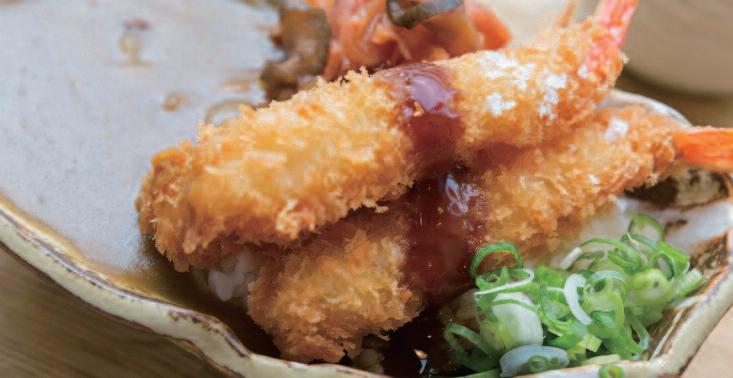
metres above sea level “It’s the only place in Japan that offers us this kind of testimony to the Edo e r a , ” h e c o n t i n u e s I t ’ s t r u e t h a t t h e r o u t e h a s been preserved as it was at that period: castles, stop-over towns, tea houses, paved paths, 100year-old cedar trees and checkpoints. Everything has been perfectly maintained as in days gone by on this particular day, it’s cold and a light rain falls on our shoulders The Hakone Hachiri leg of the journey has earned its reputation for being demanding Enormous, irregularly-shaped paving stones form the sloping, narrow pathway running a l o n g t h i s p a r t o f t h e r o u t e , o f f e r i n g m u l t i p l e opportunities to twist your ankle. It’s difficult to imagine that a few hundred years ago, this was a busy trading route, almost like a motorway, frequented by travellers carrying heavy loads, carts b r i m m i n g o v e r w i t h g o o d s , h o r s e s , a n d s e d a n chairs transporting high-ranking people But let’s continue on our way A pleasing scent of damp w o o d e m a n a t e s f r o m t h e h u n d r e d - y e a r - o l d cedars. As it’s autumn, the leaves on the trees are suffused with hues of yellow, red and ochre, and a l m o s t m a k e u s f o r g e t t h e w e t p a v i n g s t o n e s , which up to now, have made walking difficult
o w A D A k o i c h i , a n e x p e r t o n t h e h i s t o r y o f
T o k a i d o a n d d i r e c t o r o f t h e f o r m e r H a k o n e checkpoint, which is now a museum, takes out a p a i r o f r i c e - s t r a w s a n d a l s f r o m h i s r u c k s a c k :
“ T h e s e a r e w a r a j i , ” h e e x p l a i n s . “ I n t h e E d o period, travellers wore them so they didn’t slip on the paving-stones, and they were very effective If the bad weather lasted the whole of the thirteen days it took to make the journey, they needed to change them often, every two or three days ” Hakone Hashiri was an important stage in the journey as it was the the point of entry and exit to the capital. “It was easier to enter than leave E d o , e s p e c i a l l y f o r w o m e n , w h o w e r e m o r e restricted than men, ” stresses owADA koichi “ T h e r e w e r e d i f f e r e n t r u l e s d e p e n d i n g o n t h e checkpoint and its location in the Archipelago. The residents of Edo rarely left the capital and made little use of the road except in exceptional
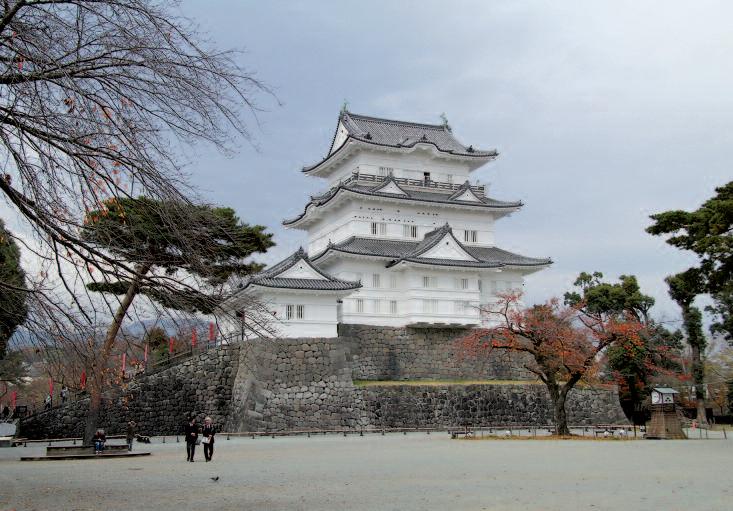
circumstances such as for funerals, to visit temples
o r t o g o t o t h e h o t - w a t e r s p r i n g s i n H a k o n e
whose use was mainly therapeutic. It was necessary to obtain an official pass to travel through the different Tokaido checkpoints, and the rules at Hakone were particularly strict and harsh It was known for being one of the most restrictive of the 53 checkpoints then in Japan ” Built 400 years ago by the Tokugawa shogunate (
Ashinoko Lake was one of the largest at the time Anyone attempting to travel illegally was liable to incur the death penalty “It even included an e
which was very rarely used by the authorities, but it was there In the registers we found 5 cases of people condemned to death.” once this checkpoint had been negotiated, it was time to take a deep breath and rest awhile before continuing on the long route to reach kyoto Travellers were

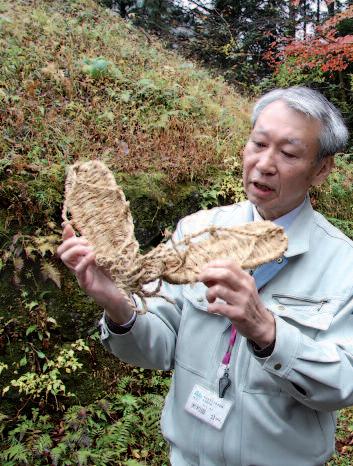




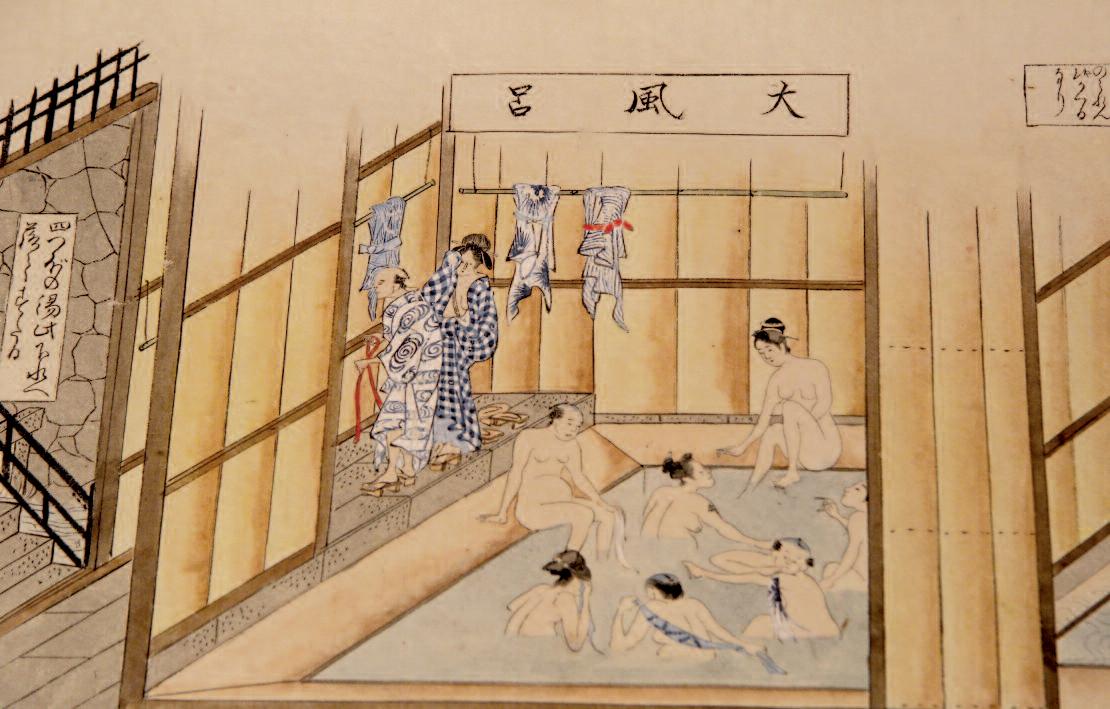
able to relax along the journey at the charming little teahouses where they could eat something and warm themselves up.
In addition to local produce, each stop along the route also had a whole range of different souvenirs on offer, original products made by skilled arti-
s a n s . I n t h i s w a y , o v e r t h e c e n t u r i e s , H a k o n e Hachiri developed its own particular local culture, which is fiercely protected to this day as a precious testimony to this hectic life of yesteryear.
yAMAMoTo Satoshi represents the third generation of owners of the Amasake-chaya tea house, situated a few steps away from the Hakone check-

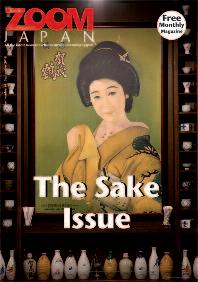



p
u n d t h e irori, a traditional Japanese sunken hearth, which has been here for over 400 years. This tea house first opened its doors around 1600, at the start of the Edo era “My family have been able to keep this place going thanks to the loyalty of our visitors,” explains this father of three. Before taking on the family business at the age of 30, he worked in the kitchen of a traditional Japanese restaurant in kyoto. He had no doubts that he would “ some day take up the reins of the family’s tea house.” w
Meiji Restoration, the little teahouse experienced

difficult periods when they had to survive with “just one customer every 10 days or so ” Amasakechaya is the last teahouse along this stretch of the road that has overcome the years of difficulty, thanks to the perseverance of this family They h
homemade amazake, a sweetened drink made with non-alcoholic fermented rice following a traditional method, as well as chikara mochi, a sticky rice paste toasted over a wood fire. “we’ve had a lot of encouragement up to now. It’s very rare for customers to come here just by chance; they usually know about the long history of our













teahouse Many people are still interested in the history of the Tokaido road and continue to walk along it to soak up the atmosphere ” After a long walk, “ you want to eat something sweet For me, t h e r u
customers and to always offer them the best drink w e c a n m a k e ” T o a c h i e v e t h i s , y A M A M o T o Satoshi gets up at dawn every day to prepare the drinks and open the teahouse, without fail, at 6 o ’clock in the morning. Establishments like the A m a s a k e - c h a y
u s e a n d t h
h
w
power of their owners helped this dynamic trade route to flourish Stopping-places, funded by the shogunate, were built all along the route in order to make travel easier and to help trade The point of departure from Hakone Hachiri, the fortified town of odawara, was, unquestionably, one of t h e m o s t i m p o r t a n t t r a n s i t - p o i n t s . w i t h 9 0 shops, it was best known throughout the archipelago for its kamaboko, a kind of fish paste used in many Japanese dishes Twelve brands specialising in its production have set up here here over the centuries, creating the kamaboko Road! This still exists, thanks to the tenacity of a handful of entrepreneurs Kamaboko is in decline in Japan, but in odawara it has made a particularly succ e s s f u l c o m e b a c k a n d h a s b e c o m e t h e c o r n e rs t o n e o f s e v e r a l p r o d u c e r s “ H i s t o r i c a l l y , odawara is a fishing village,” says TASHIRo Moritaka. “Buri (yellowtail fish) was particularly abundant This was what allowed the town to develop, e v e n d e fi n e i t s i d e n t i t y K a m a b o k o i s a v e r y healthy food, which goes fantastically well with sake.” Since 2014, young artisans have formed a group to revitalise the kamaboko Road, and they aim to put on numerous events in support “we want to relaunch this place, for example by recrea t i n g s c e n e s o f t i m e s g o n e b y i n t h e E d o a n d M e i j i p e r i o d s w h e n o d a w a r a w a s s t i l l a s m a l l fi s h i n g v i l l a g e w e ’ r e c o n v i n c e d o d a w a r a ’ s strength lies in its roots. ”
The history of the Hakone region would not be c o m p l e t e i f w e o m i t t e d i t s f a m o u s h o t - w a t e r springs The spa ’ s very first bath house opened
www.zoomjapan.info
Published by Zoom Japan UK Limited
1 Kings Meadow, Osney Mead, Oxford, OX2 0DP, UK sales@zoomjapan.info
ISSN : 2050-5108 Printed in the UK
In cooperation with Zoom Japon (FR)- Ed Ilyfunet
Publisher: IWASAKI Hirohisa
Editorial: ODAIRA Namihei, Gabriel Bernard, Eric Rechsteiner, Jean Derome, Gianni Simone, Johann Fleuri, SEKIGUCHI Ryôko, MAEDA Haruyo, Jérémie Souteyrat, Alissa Descotes-Toyosaki
Translation: Susana Brown, Niki Mellor, Alan Gardner
Production: A Concept Ltd.
Sales: SAKAI Katsushi, FUKUSHIMA Shihomi, TAKACHI Yoshiyuki, A Concept Ltd.
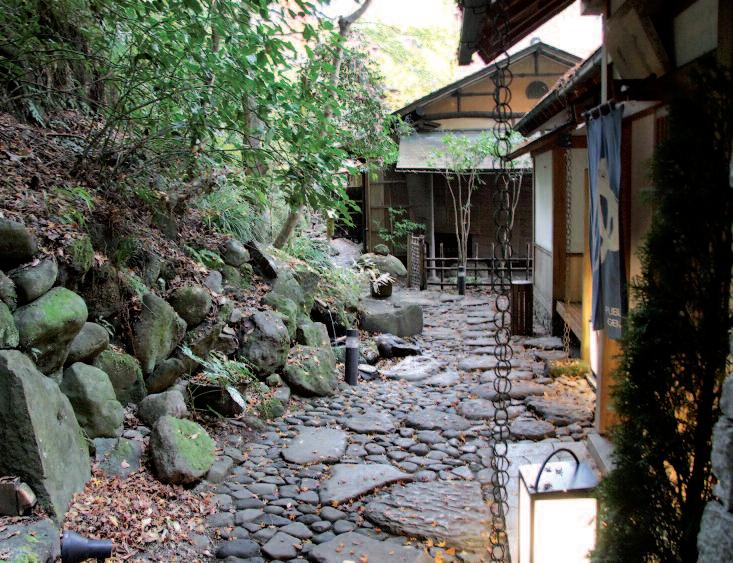
in the Nara period (710-794), and the famous Seven Hot Springs of Hakone would have particularly appealed to the crowds during the Edo period, due to the growing reputation of their therapeutic merits. After the Restoration of Meiji, the bathhouses increasingly developed as they benefitted from better access The owners of traditional inns invited the best architects in the country in order to renovate their buildings and transform some of them into wooden buildings several storeys high This happened to Bansuiro F u k u z u m i , w h i c h h a d b
n i n e x i
n c e s i n c e 1625. It draws its water from the oldest hot spring in Hakone FukuzuMI Haruhiko, its director, agrees to take us to see this famous spring, however, we ’ re not allowed to film or photograph it. Behind a double-padlocked iron door leading to the interior of the rock, the heat from the volcanic water rises
and warms our cheeks. “It’s best to climb down the ladder and get closer to see it,” he smiles The walls of the cave are hot and moist as we approach the water of this spring, which is now just a few metres below our feet. Here, in the palm of one ’ s hand, is water that’s almost 50°C and has been curing physical ailments for centuries
JOHANN FLEURI
FROM TOKYO, the easiest way is to take the Odakyu line from Shinjuku to Hakone-Yumoto. For a journey to remember, think about travelling on the Romancecar express train (75 minutes, ¥2280/£15.70), a Japanese railway legend (www odakyu jp/english/romancecar) The company also offers several other lowpriced options. (www.odakyu.jp/english/passes/)




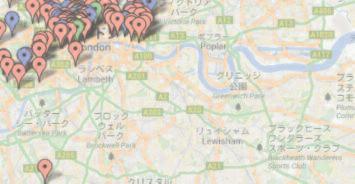








Hello there! This column will include useful Japanese phrases that cover a variety of topics.
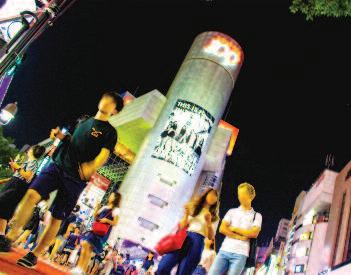
Konnichiwa, Mina-san! (Hello, everyone!) when are you struck by a sense of the times in which you live? when you compare how fashion and music have changed from the past? when you see how technology has changed? There are so many moments when we can sense the changing of the times Recently, I’ve often felt this changing of the times when I encounter certain words, how about all of you?
“An era ” “平 成 31年 4月 30日 ” (30/04/2019)
This date is fast approaching, but for Japanese people particularly this is an important day that will be marked in history Do you know why? Before I tell you the answer, let me explain why “平成31年 Heisei 31 nen(year)” becomes “2019 年nen(year)” in English. In Japan, there are two ways of writing the year: “wareki” means Japanese calendar and “seireki” means western calendar. Isn’t it a bit of a faff to have two different ways of writing the year? …you might well ask. Truthfully, even Japanese people can ’ t always immediately convert seireki to wareki, but even
so to Japanese people, the “wareki” naming system is an important “unit” used to convey the beginning and ends of eras Since the end of the M e i j i E r a ( 1 8 6 8 - 1 9 1 2 ) t h e s e e r a n a m e s a r e changed only upon imperial succession So in other words, “Heisei 31 nen ” means that it has been thirty-one years since the beginning of the era named “Heisei” So getting back to what I was saying about an important day that will be noted down in Japanese history, “平 成 31年 4月
3 0 日 ” w i l l b e t h e l a s t d a y o f H e i s e i F r o m 1 s t
May, a new “ era ” will begin!
At the beginning of this week’s column, I talked about words that make you sense the changing of eras In every era, there have always been “若者言 葉 wakamono kotoba (slang used by young people)”. In Japan, particularly entering the Heisei period, there have been various trendy words or young people slang, but there are so many words that today’s young people use that even I, a “Heisei-born” person, can ’ t understand. I thought I would introduce a few of those to you:
“電車なうDensha nau (I’m on the train)” This word takes the pronunciation of the English word “ now ” and puts it into Japanese writing Japanese slang words are formed in a number of ways There are a lot of other words that are derived from English, or words formed by joining up the first letters of other words, or words that are abbreviations of Japanese words or phrases It can be hard for people seeing these words for the first time to guess their meaning! And so, words can carry a sense of an “ era ”
Right now I bet that young people in Japan are saying something like:
Hanami nau Paripi ookute kusa 花見なう。パリピ多くて草。
(I’m at a cherry blossom viewing party There’re lots of party people. Lol)
Sayoonara, Jaa mata! さようなら、じゃあまた! (Goodbye, see you!)

Had you heard of or seen any of these words before? These words are said to be born on and popularised by social media “なうnau ” is used when you are going on a trip or meeting with your friends to tell your friends briefly what your current location is, for example: “大阪なうOsaka nau (I’m in osaka)”



‘Minato’ – learn Japanese and interact with fellow students around the world online https://minato-jf jp/















